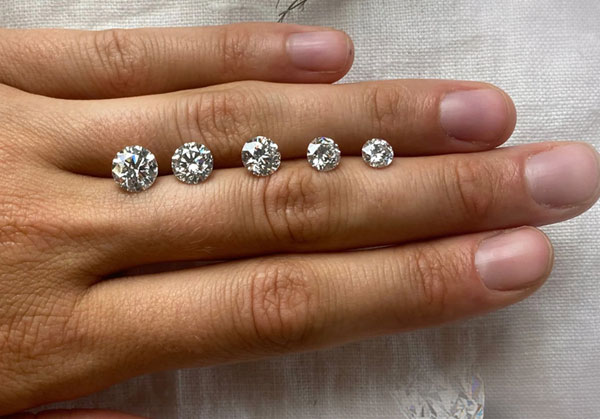What you need to know about NATURAL Diamonds

There is no question that natural diamonds are the ultimate symbol of enduring love and timeless beauty. Their brilliance, fire, and scintillation make them an iconic choice for engagement rings and fine jewelry. Beyond their visual allure, natural diamonds carry a deeper story—one of transformation, patience, and nature’s craftsmanship.
The earliest diamonds were discovered in India around 4th century BC, where they were prized for their ability to refract light. Ancient Indian texts referred to diamonds as "Vajra," meaning thunderbolt, symbolizing strength and invincibility. The Hope Diamond, one of the most famous diamonds in the world, is believed to be over 1.1 billion years old and weighs a stunning 45.52 carats. Today, natural diamonds remain synonymous with luxury, romance, and timeless elegance.
What is a Natural Diamond?
A natural diamond is a precious gemstone formed deep within the earth’s mantle under intense heat and pressure. Composed of carbon atoms arranged in a perfect crystal structure, natural diamonds are the hardest naturally occurring substance on Earth, ranking 10 (the highest) on the Mohs hardness scale.
Each natural diamond is unique, with its own set of inclusions and characteristics that serve as a fingerprint of its journey from deep within the earth to the surface. These imperfections, known as inclusions, are nature’s signature, making every diamond one-of-a-kind.
Natural diamonds are billions of years old—some dating back over 3 billion years—making them the oldest thing most people will ever touch!

Are Natural Diamonds Rare?
Yes, natural diamonds are rare—and the larger and higher quality the diamond, the rarer it becomes. While small, commercial-grade diamonds are more commonly found, gem-quality diamonds larger than one carat are increasingly scarce.
Only about 1 in 1 million mined rough diamonds is large enough and of sufficient quality to be cut into a one-carat finished gemstone. Diamonds over two carats with exceptional clarity and color are even more elusive, making them highly coveted in the world of fine jewelry. The largest diamond ever discovered is the Cullinan Diamond, weighing an astonishing 3,106 carats before being cut. Pieces of this legendary stone are part of the British Crown Jewels.
Price and Resale Value of Natural Diamonds
Natural diamonds retain strong value due to their rarity and historical significance. While diamond prices fluctuate based on market trends, larger, high-quality natural diamonds tend to appreciate over time, especially if they possess exceptional characteristics in cut, color, clarity, and carat.
When it comes to resale, natural diamonds generally have higher resale value compared to lab-grown diamonds. Because natural diamonds are finite and cannot be replicated by nature, they maintain a level of intrinsic value.
Natural VS Lab-Grown Diamonds
| Feature | Natural Diamonds | Lab-Grown Diamonds |
|---|---|---|
| Origin | Earth’s mantle | Lab-created process |
| Formation Time | Billions of years | 2-12 weeks |
| Composition | 100% carbon | 100% carbon |
| Cost | Higher price point | More affordable |
| Uniqueness | One-of-a-kind | Consistently high quality |
| Resale Value | Higher | Lower |
| Ethics & Environment | Higher impact due to mining | Lower environmental impact |
Is Diamond Certification Important?

Yes! A reputable diamond should come with a certification from an independent gemological laboratory. They evaluate and grade diamond quality based on cut, color, clarity, and carat weight (4C’s).
Certification provides authenticity, value assurance, and helps with resale and insurance. Certification is proof that your diamond is genuine and accurately graded. A certified diamond ensures you’re paying for the quality you expect. Certification also helps with resale value and insuring your diamond, as it offers a professional and objective evaluation.
All SAMA diamonds are independently verified by a trained gemologist at either Gemological Institute of America (GIA) or the International Gemological Institute (IGI), the world’s most well-known and respected labs.
Why Should You Choose a Natural Diamond?
Owning a natural diamond is like holding a piece of Earth's history—one that took billions of years to form. If their rarity and historical significance appeal to you, opt for a natural stone. They are often passed down as heirlooms, carrying stories and memories through generations to come.
While natural diamond mining has a significant environmental footprint, vintage and antique diamonds provide a more eco-conscious choice. Historically, diamond mining also raises ethical concerns about conflict diamonds. Today, the Kimberley Process helps prevent the trade of diamonds used to finance armed conflict, with over 99% of the world’s rough diamonds now certified as conflict-free.
Pro Tips:
- Want a rock that’s been around for a couple of billion years? Natural diamonds embody the essence of everlasting love.
- A symbol of wealth, beauty, and strength throughout history, they’re destined to sparkle for generations to come.



